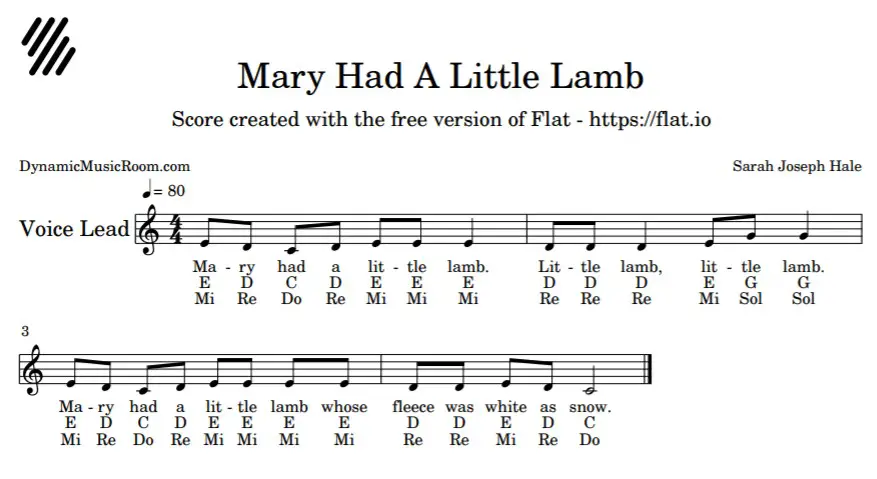Singing in solfege is a ton of fun.
My kids love trying to figure out songs using solfege syllables (I know, they’re music geeks), so they tried to find out Mary Had A Little Lamb solfege.
The solfege syllables for Mary Had A Little Lamb is simple and includes only 4 pitches: do, re, mi, and sol. Here are the phrases broken down:
- Mi re do re mi mi mi re re re mi sol sol
- Mi re do re mi mi mi re re mi re do
Look below or the solfege and historical information on the famous folk song.
Table of Contents
Notes For Mary Had A Little Lamb In Solfege
You can do this song in any key. Most often, you’ll it in the key of C major which I’ve included in the notation as follows.

Look at how solfege syllables work and how it develops an ear for music learning.
What Scale Is Mary Had A Little Lamb?
Traditionally, Mary Had A Little Lamb is performed in C major, but any major key will work. For the purposes of children singers and recorders, you may be better off putting it in the key of G major.
This easy usage of notes is why the music director will use this as a staple song in the beginning of instrumental music education.
How Do You Play Mary Had A Little Lamb?
Playing Mary Had A Little Lamb isn’t tricky, and there is a shortcut as well. If you start on Bb (the right-most black key in the group of 3), you can play it easily.
Music practice is all about breaking the steps for music learning down.
Here are the steps I take when teaching new piano players how to play Mary Had A Little Lamb.
#1 Find The Correct Pitch
Find your correct starting pitch. For brand-new people, I recommend either E or Bb.
If choosing E, look for the two black keys. The E is the white key to the right and touching the right-most of the 2 black keys.
If choosing Bb (the easiest option), look for the group of 3 black keys. Bb is the right-most of the 3 black keys.
#2 Place Your Fingers
Using your right hand, put your middle finger on the key you chose from before. We’ll call this finger “3” from now on.
If you start on E, place your pointer/index finger on the white key to the left of finger 3. This note is D, and we’ll call the pointer “2”.
Next, place your thumb on the next white key. This is called C, and we’ll the thumb “3”.
If you start on Bb, place your pointer on the middle black key. This is Ab and finger 2.
Next, place your thumb on the bottom black key. This is Gb and finger 3.
For the rest of this explanation, I’ll just refer to finger numbers. This works with both starting notes.
#3 Down and Up
Now it’s time to start playing. Before I let a music learner see the notes, I want them to hear it.
I will tell them how to play the notes in the following way.
Starting on finger 3, your job is to play down and then right back up like this:
3 2 1 2 3
Once you’ve got this, it’s time for the next step.
#4 Repeat 3, 2, And Jump
Add on two more 3s. So you have three at the end.
3 2 1 2 3 3 3
Repeat the same step with the 2s. We want three of them added on.
3 2 1 2 3 3 3 – 2 2 2 –
Go back to the 3 and play it once. Then, jump up to your 5 finger on either G (two white keys up for people starting on E) or Db (next black key up for people starting on Bb).
You pinky or little finger should be playing this note.
3 2 1 2 3 3 3 – 2 2 2 – 3 5 5 –
Note: Instead of jumping to 5, you could just repeat 3 again twice.
#5 Like The Beginning
Now, you add on the beginning including the three 3s.
3 2 1 2 3 3 3 – 2 2 2 – 3 5 5 –
3 2 1 2 3 3 3 –
#6 Fancy Ending
And it’s time for the fancy ending. In all honesty, this is the part most people have trouble with. With my students, it just comes down to repetition.
The fancy ending plays two 2s and then ends with 3 2 1.
3 2 1 2 3 3 3 – 2 2 2 – 3 5 5 –
3 2 1 2 3 3 3 –
2 2 3 2 1 – – –
Congrats! Now you know how to play Mary Had A Little Lamb on piano. For more visuals and piano music learning, check out this video.
What Is The Meaning Of Mary Had A Little Lamb?
Mary Had A Little Lamb is a folk song based on an American nursery rhyme. Unlike many folk songs, we have a clear origin of this folk song which is credited to Sarah Joseph Hale in 1837. (You may also enjoy checking out Skip To My Lou.)
Supposedly, a young girl named Mary Sawyer took her lamb at school one day, and the incident inspired the now-famous lyrics.

Merrily We Roll Along Vs Mary Had A Little Lamb
Merrily We Roll Along’s connection with Mary is iconic and long-standing. So much so that the two are considered interchangeable.
However, their history actually shows that the songs are somewhat different.
Merrily We Roll Along is the chorus of the song Goodnight Ladies written by Edwin Pearce Christy in 1847. It was later released as its own song in 1867.
In band and instrumental literature, it is typically performed the same as Mary Had A Little Lamb without the jump up to sol (or G in C major) at the end of the first phrase. It stays on the mi (or E in C major).
This is not traditionally how the song was performed. The reason the song was changed is to make it possible to play this song with three pitches early in the students’ musical learning.
In truth, the pitches are kept exactly the same, but the rhythm for both instances of “Mary” and “…fleece was” are changed from straight paired eighth notes to dotted eighth-sixteenth.
The songs are so close because Christy based Merrily off of Mary’s melody. It’s speculated the reason for doing this in the chorus of his song is because he wanted a well-known, simple tune that would stick in people’s heads and be easier to sing.
Conclusion
I hope you enjoyed learning the Mary Had A Little Lamb solfege. The song isn’t hard, and it makes a great early recorder or solfege song to teach.
Check out Happy Birthday in solfege.

